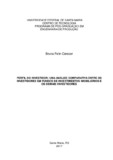| dc.creator | Cerezer, Bruna Felin | |
| dc.date.accessioned | 2018-09-04T19:12:39Z | |
| dc.date.available | 2018-09-04T19:12:39Z | |
| dc.date.issued | 2017-08-09 | |
| dc.identifier.uri | http://repositorio.ufsm.br/handle/1/14185 | |
| dc.description.abstract | Behavioral Finance is a field that studies the influence of the psychological aspects of indi-viduals in the process of decision making regarding their finances. Generally, during the de-cision-making process, investors are influenced by emotions and feelings, which can lead to wrong decisions, resulting in financial losses. In particular, investors of Real Estate Invest-ment Funds have grown recently. Such funds are an attractive opportunity to diversify in-vestments, as it allows investors to invest their resources in assets related to real estate market without the need to buy a property. This ease of access to the real state market, coupled with the recent expansion of the sector, may cause investors to opt for this type of investment based on emotional factors. Still, the FIIs are indicated for all investor profiles, for both, conservative, moderate and aggressive. Therefore, the difficulty in directing the FIIs as an investment option for the investor that presents the greatest interest for FIIs. Thus, the objective of this study is to identify the profile of investors in real estate investment funds, as well as other investors. For this, a questionnaire was applied to investors from three cities in the state of Rio Grande do Sul. The Kruskal-Wallis test was implemented in order to identify if there are significant differences in the levels of influence of behavioral factors between FII investors and other investors, and among investor profiles as well. According to the results, there was no significant difference between the levels of influence of the behavioral factors between the investors in FIIs and the other investors, but there was a difference in some be-havioral factors between the moderate and aggressive investors profile. The behavioral fac-tors, present in most investors, are the following: self-control, representativeness, asymmetry effect, familiarity / affinity, house money effect, fear of repentance, selective memory, cogni-tive illusions, result oriented, gambler’s fallacy / retrospective and disposition effect. It was identified that most investors with an aggressive profile invest in FIIs, suggesting that the Brokerage House direct this investment option to its clients with this profile. | eng |
| dc.language | por | por |
| dc.publisher | Universidade Federal de Santa Maria | por |
| dc.rights | Attribution-NonCommercial-NoDerivatives 4.0 International | * |
| dc.rights.uri | http://creativecommons.org/licenses/by-nc-nd/4.0/ | * |
| dc.subject | Finanças comportamentais | por |
| dc.subject | Perfil do investidor | por |
| dc.subject | Investidores em fundos de investimentos imobiliários | por |
| dc.subject | Behavioral finance | eng |
| dc.subject | Investor profile | eng |
| dc.subject | Investors in real estate investment funds | eng |
| dc.title | Perfil do investidor: uma análise comparativa entre os investidores em fundos de investimentos imobiliários e os demais investidores | por |
| dc.title.alternative | Investor profile: a comparative analysis between investors in real estate investment funds and other investors | eng |
| dc.type | Dissertação | por |
| dc.description.resumo | A área de Finanças Comportamentais estuda a influência dos aspectos psicológicos dos indivíduos no processo de tomada de decisões referentes às suas finanças. Geralmente, no processo decisório, os investidores são influenciados por suas emoções e sentimentos, o que pode conduzir a decisões equivocadas, acarretando em perdas financeiras. Particular-mente, os investidores de Fundos de Investimentos Imobiliários (FIIs) têm crescido recente-mente. Tais fundos são uma oportunidade atrativa para diversificar seus investimentos, pois permite ao investidor aplicar seus recursos em ativos relacionados ao mercado imobiliário sem, de fato, necessitar comprar um imóvel. Essa facilidade de acesso ao mercado imobiliá-rio, associado à recente expansão do setor, pode fazer com que investidores optem por es-se tipo de investimento com base apenas em fatores emocionais. Ainda, os FIIs são indica-dos para todos os perfis de investidor, tanto para os conservadores como moderados e a-gressivos, com isso, tem-se a dificuldade em direcionar os FIIs como opção de investimento para o perfil de investidores que apresente maior interesse pelos FIIs. Assim, o objetivo des-te estudo é conhecer o perfil dos investidores em fundos de investimentos imobiliários, bem como os demais investidores. Para isso, foi aplicado um questionário com investidores de três cidades do estado do Rio Grande do Sul e realizado o teste Kruskal-Wallis para identifi-car se existem diferenças significativas nos níveis de influência dos fatores comportamentais entre os investidores de FIIs e os demais investidores, assim como entre os perfis de inves-tidores. Diante dos resultados, constatou-se não haver diferença significativa entre os níveis de influência dos fatores comportamentais entre os investidores em FIIs e os demais inves-tidores, porém encontrou-se diferença em alguns fatores comportamentais entre os perfil de investidores moderado e agressivo. Os fatores comportamentais presentes na maioria dos investidores são os seguintes: autocontrole, representatividade, efeito assimetria, familiari-dade/afinidade, efeito dinheiro da casa, medo de arrependimento, memória seletiva, ilusões cognitivas, voltado para o resultado/caráter recente, falácia do jogador/retrospectiva e efeito disposição. Identificou-se que a maioria dos investidores com perfil agressivo investe em FIIs, sugerindo então que a Corretora direcione esta opção de investimento para seus clien-tes com este perfil. | por |
| dc.contributor.advisor1 | Weise, Andreas Dittmar | |
| dc.contributor.advisor1Lattes | http://lattes.cnpq.br/1329623071793399 | por |
| dc.contributor.advisor-co1 | Braghirolli, Lynceo Falavigna | |
| dc.contributor.advisor-co1Lattes | http://lattes.cnpq.br/2992623886366532 | por |
| dc.contributor.referee1 | Hornburg, Ricardo André | |
| dc.contributor.referee1Lattes | http://lattes.cnpq.br/9095738380799368 | por |
| dc.contributor.referee2 | Ribeiro, Roberto Portes | |
| dc.contributor.referee2Lattes | http://lattes.cnpq.br/7168826495310439 | por |
| dc.creator.Lattes | http://lattes.cnpq.br/4123084820974107 | por |
| dc.publisher.country | Brasil | por |
| dc.publisher.department | Engenharia de Produção | por |
| dc.publisher.initials | UFSM | por |
| dc.publisher.program | Programa de Pós-Graduação em Engenharia de Produção | por |
| dc.subject.cnpq | CNPQ::ENGENHARIAS::ENGENHARIA DE PRODUCAO | por |
| dc.publisher.unidade | Centro de Tecnologia | por |



